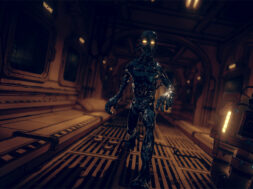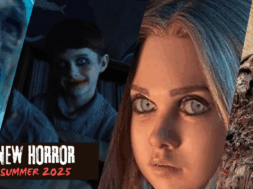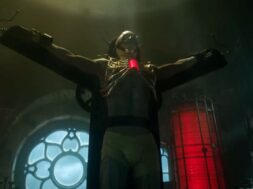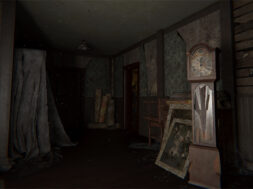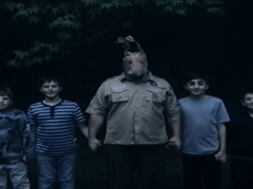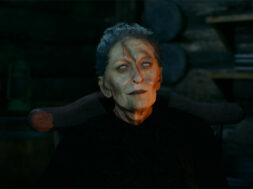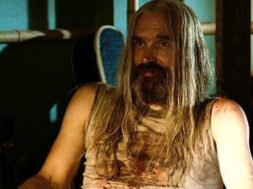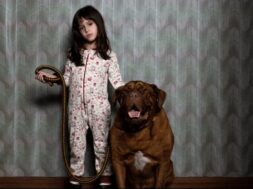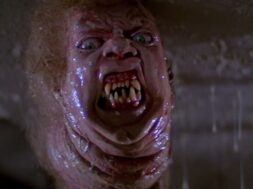The Screaming Bear Attack Scene from ‘Annihilation’ Was One of This Year’s Scariest Horror Moments
*Keep up with our ongoing end of the year coverage here*
When the opportunity to write about the best horror of the year came up, my thoughts immediately turned to Annihilation, which has occupied the top spot on my list of the year’s best films since its release back in February. Check out Bloody Disgusting’s original review here.
It doesn’t matter whether or not the film reads as a “traditional” horror film (for my money, there’s been far too much digital ink spilled this year on semantic discussions about “elevated” and “prestige” horror). Even if you consider Annihilation a work of science fiction, the film features what is undoubtedly one of the most terrifying horror set pieces of the year. I’m talking, of course, about the screaming bear sequence.
Annihilation is based (primarily) on the first book in Jeff VanderMeer’s Southern Reach trilogy. The book follows a quartet of unnamed female scientists as they explore the Shimmer, a strange environmental phenomenon that has physically altered a large geographical area and its residents in strange, alien ways. The women are the latest in a long line of expeditions; the others have either never returned or returned irrevocably different (and inevitably die).
The film adaptation by Alex Garland (Ex Machina) uses the book’s premise as a foundation, but aside from carrying over the characters, Garland radically alters the plot; this results in an adaptation that makes visually explicit some of open-to-interpretation horrific elements without compromising on the source material’s atmosphere of ominous and oppressive dread.
The best example of this occurs at roughly the 75-minute mark of the film. In the book, the women encounter an abstract, ill-defined monster called the Creeper in a submerged well that circles deep underground. Garland’s screenplay eliminates the well and literally visualizes the Creeper; in the film its stand-in is a massive bear whose snout is half skeleton and whose vocal mannerisms mimic the screams and voice of its victims. Nicknamed Homerton (after East London’s “rough-around-the-edges” train station) by visual effects supervisor Andrew Whitehurst, the sequence when the creature is finally revealed is a masterclass of tension, effects and horror.
Immediately before Homerton appears, Anya (Gina Rodriguez) ties up her colleagues and holds them at gunpoint. She’s distraught by the suggestion that since entering Area X, their DNA has been changing, as well as the revelation that Lena (Natalie Portman) lied that her husband was a member of a previous expedition. These realizations, as well as her mounting paranoia, prompt Anya to lash out. The threat of human violence is a bait and switch, however; before Anya can harm her colleagues, she is lured outside by the cries of Cass (Tuva Novotny) who was abducted and mauled to death the night before.
Like VanderMeer’s book, what (initially) occurs to Anya is left to the imagination offscreen. Garland wisely keeps the camera trained on Lena, Josie (Tessa Thompson) and Ventress (Jennifer Jason Leigh)’ faces as the soundtrack is the silence after Anya runs out before it is filled with the roars of something. As they struggle to free themselves from their bonds, the wheezing, screaming creeps closer, until a cut to a medium shot reveals the slow lumber of a massive, mutated bear towards them. Garland cuts back to the same shot as the deformed snout slowly pushes between Lena and Josie, in a shot that evokes countless Xenomorph encounters in the Alien franchise. Meanwhile, the soundtrack is filled with the anguished screams of a woman we know is dead coming from the mouth of a monstrous beast, which creates an uncanny disconnect between sight and sound.
The slow, deliberate pace of the creature as it first pulls back, then circles around in front of the confined women is unbearable (pun intended). Garland masterfully delays, then delays further the impending attack, drawing out the tension for maximum effect. The fact that the entire scene is lit by a solitary flashlight in the far right corner of the frame, Garland’s judicious lack of editing and the decision to continually focus on close-ups of the women’s shaking, crying faces only serves to ratchet up the fear quotient. Then, following a close up (from Josie’s point of view) of Homerton’s gaping open mouth and a shot-reverse-shot of the bear clamping down on her left shoulder, Anya unexpectedly returns to open fire on the beast (narrowly avoiding her friends in the process).

At this point, the sequence becomes a full-blown action set piece. Homerton is repeatedly struck by gunfire before charging, knocking over Josie and crushing Anya against the wall as she attempts to retreat. At this point, the editing kicks in: there are a number of quick cuts as Lena and Josie try to free themselves, as well as long shots (framed half in shadow) of Anya being mauled. The camera cuts to a vantage point halfway up the stairs while Anya is grabbed by the legs, snapping one of the banisters clean off (a clear, efficient visual shorthand to demonstrate how forcefully Homerton pulls her). Then, in quick succession, she is pounced on and her throat is brutally ripped out.
The soundtrack is filled solely with Anya’s anguished screams (there is no extradiegetic music), which makes her death scene feel both louder and longer than it is (from Homerton’s charge to the quick overhead shot of her corpse, only 20 seconds has passed). In fact, it is only when lead protagonist Lena is attacked and nearly mauled that the more traditional action movie score kicks in. Shortly thereafter Josie manages to put the bear down with a barrage of gunfire at close range, closing out the roughly two-minute sequence.
As a film, Annihilation is thematically interested in how people evolve and change; the film has been alternately celebrated and criticized for its open-ended narrative and philosophical elements. Since its release, Annihilation has been discussed as a metaphor for the human condition, the uncanny, trauma, depression and cancer. The range and multitude of readings confirms how magnificently nuanced and rich Garland’s second directorial effort is.
The scene with Homerton is emblematic of the film’s many layers and complications. Anya’s initial actions are driven by the revelation that their bodies are literally turning against them, an unsettling notion that also exposes the lack of control she – a soldier struggling with depression – has over her surroundings. Her paranoia is externally manifested when she discovers that she has been lied to by Lena (representing a threat from within the community) before realizing that there is always the threat of outsiders – represented by Homerton. In this way, not only is the scene a stunningly effective piece of mood, tension and horror, it is a microcosm of the film’s many thematic concerns…all wrapped up in one beautifully rendered scare.
